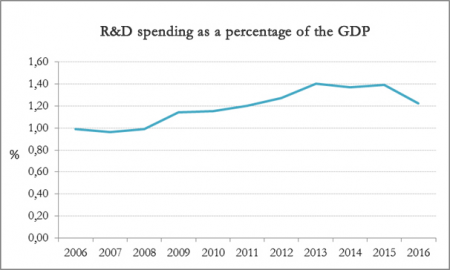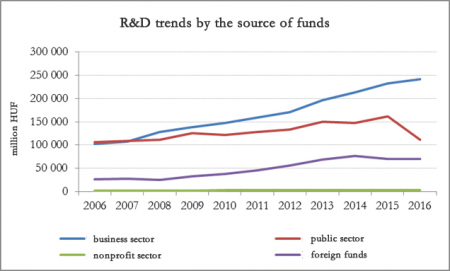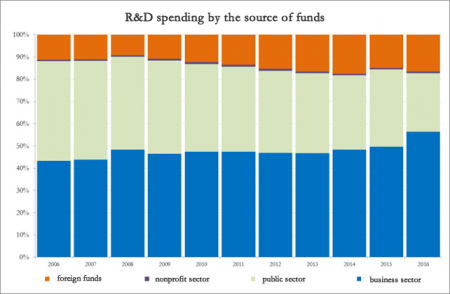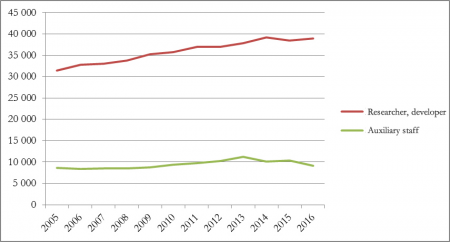The activities of the National Research, Development and Innovation Office (NRDI Office) in the long run may contribute to reinforce positive trends and buck infavourable tendencies in order to put domestic RDI on a growth trajectory.
R&D spending as a percentage of the GDP
R&D spending means the actual utilisation of the funds available for research, development and innovation.
 |
|
Figure 1: R&D spending as a percentage of the GDP |
R&D spending amounted to HUF 427.2 billion (EUR 1,4 billion) in 2016. The amount of R&D expenditure financed from the central budget dropped to HUF 112.1 billion (EUR 370 million) in 2016 from the HUF 162.2 billion (EUR 530 million) in 2015. Funds financed from the central budget include funds used from the EU’s Structural Funds and the domestic National Research, Development and Innovation Fund (NRDI Fund) which aim to promote and develop the Hungarian RDI sector.
The decrease in the use of public funds is partly due to the fact that in 2016 payments were no longer made under the calls of the 2007-2013 programming period, but the payments from the NRDI Fund and the EU funds, which had substantially increased compared to previous years, had not reached a level in the use of funds that would be reflected in the statistics. The RDI-spending-to-GDP ratio was 1.22% in 2016 (compared to 1.39% in 2015).
The 2016 data on spending (i.e. actual use of funds), therefore, not yet reflect the following trends that are already known in actual figures:
- The amount of payments from the NRDI Fund significantly rose in 2016 because the budget made available for RDI programmes and projects was increased to HUF 83 billion (EUR 270 million) from the HUF 53 billion (EUR 160 million) in previous years. Payments from the NRDI Fund to a project, however, do not qualify as use of funds from the perspective of statistics which cover a longer term of up to several years, so these payments are not reflected in the 2016 data published by the KSH.
- In addition to this, since 2015 altogether HUF 519 billion (EUR 1,7 billion) has been made available for RDI projects in non-refundable EU funding which will only be reflected in statistics a few years later.
- 74% of the budget available for the regions outside the capital and Pest county has already been awarded totalling to HUF 350 billion (EUR 1,15 billion), including HUF 272 billion (EUR 890 million) already contracted and HUF 227 billion (EUR 740 million) already disbursed to the beneficiaries.
- Of the HUF 48 billion (EUR 160 million) fund available in the central region (Budapest and Pest county) for RDI projects HUF 11 billion (EUR 40 million) has been awarded and further announcements are about to come soon in other calls as well.
- As regards refundable EU funds, a total of HUF 192 billion (EUR 630 million) can be spent on research, development and innovation. Financial instruments such as preferential credit facilities, schemes combined with credit and venture capital funds are still available for applicants so awards decisions are expected later in these calls.
Private and public R&D expenditure
R&D expenditure is composed of the following four sources: business spending, public spending, nonprofit spending and foreign funds.
The four types of sources together account for the total domestic R&D expenditure (Figure 1). More and more funds are earmarked for R&D activities by businesses as shown on Figure 2 (56% of all R&D expenditure was given by the business sector. 10 years ago, in 2006 the sector’s share was less than 43%, as shown on the Figure).
 |
|
Figure 2: R&D spending by the source of funds |
 |
|
Figure 3: R&D trends by the source of funds |
Researcher headcounts
According to the preliminary HCSO statistics the number of researchers increased by 500 in 2016 compared to the previous year. Still, the total number of employees in RDI positions have decreased as this figure also includes auxiliary staff. It is evident from the preliminary data for 2016 that the decrease is due to the decrease in auxiliary staff.
 |
|
Figure 4: Trends in researcher and auxiliary staff headcounts |
Besides facilitating the long-term growth in the number of researchers, the quantity indicator must be completed with quality objectives. The system of competitive calls aims to make the researcher career more attractive, and to ensure the number of researchers that is necessary for the sustainable and competitive operation of research institutions. Such programmes include the revamped Researchers’ Thematic Applications Programme and the Call for Postdoctoral Applications. A new knowledge transfer model will be developed under schemes promoting the creation of Centres for Higher Education and Industrial Cooperation aimed at the successful cooperation between researchers from the business sector and the academy.






